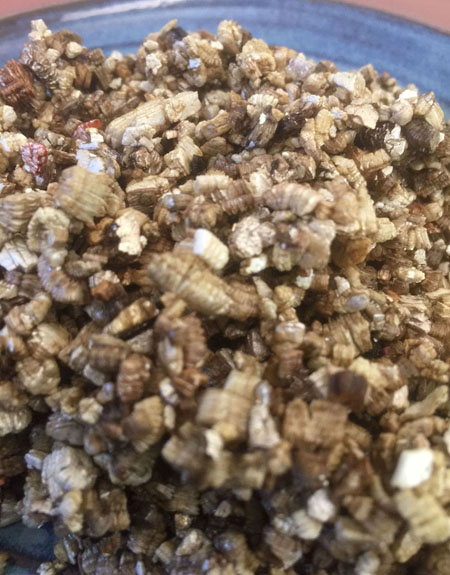Perlite VS Vermiculite

Perlite & Vermiculite are inorganic soil additives commonly used by gardeners. We all add them automatically to potting soil routinely as it is the done thing, but what are they actually for? What do they do? Do they not do the same thing? or are they different?
| PERLITE | VERMICULITE | |
 |
 |
|
| APPEARANCE | Perlite is an irregular, white, hard, crumbly, porous material. | Vermiculite is a irregular (worm like), brown/shiny, soft, spongy material. |
| MANUFACTURE | Made by super-heating volcanic hydrous obsidian. | Made by super-heating aluminosilicate. |
| PH | PH 6.5 - 7.0 | ± PH 7.0 |
| BUFFERABLE | No. | Yes. |
| COMPOSITION | Silicon Dioxide SiO2. | aluminium, iron oxides, magnesium oxides. |
| MICROBIAL | Inorganic, Sterile. | Inorganic, Sterile. |
| NUTRIENTS | None. | Potassium, Magnesium, Calcium. Able to absorb nutrients. |
| STRUCTURE / DENSITY |
Honeycomb, hard. Light. | Layered, spongy. Light. |
| WATER DRAINAGE | Good drainage. | Drainage not as good. |
| WATER RETENTION | Water retention not as good. Retains some water. Dries fast. | Good water retention. Soaks up moisture. Slower to dry. |
| AERATING | Good for aeration. Holes in material create air pockets. High air porosity. | Not as good for aeration. Absorbent nature negates aeration. Medium air porosity. |
| APPLICATION |
Add to soil that requires better drainage and lower water retention. Plant cuttings & propagation. |
Add to soils that require more water retention. Seed germination and seedlings. |
| SUITED |
Plants that prefer drier roots/soil. |
Plants that prefer moist roots/soil. |
Our observations
We conducted comparative experiments to observe the respective water handling properties of Perlite & Vermiculite. 200ml of tap water was added to 200ml of each material to see how the materials interacted with water. Our observations concluded that adding water to both substances did not show any significant swelling of either material. The size of particles for both Perlite and Vermiculite remained constant in the presence of water. In our particular experiment we observed and found that the amount of water retained by Vermiculite was actually greater than than that of Perlite. We also observe that the drainage of water from Perlite after removing both substances from their water was greater than that of Vermiculite. In other words Perlite retained less water than Vermiculite. We conclude that Vermiculite does not appear to drain off water as well as Perlite. Which ties in with the claim that Vermiculite retains moisture in the soil for longer. Perlite dries out quicker.
Over time, we found that structurally, Perlite retained it’s integrity – while Vermiculite seemed to compress in the medium. This was certainly the case in the highveld, where summer rains are heavy.
But what does this all mean for chillies? Oddly enough, we have found that Perlite works well in the highveld where the summer rain fall can be heavy. In these conditions we have found that Vermiculite retains too much moisture, to the detriment of the plants. Over time the vermiculite compresses in over wet soils, making potting mediums dense and fecund.
In areas of high rainfall we would recommend using Perlite. Perlite does not loose its structural integrity given high levels of moisture and soils are more inclined to dry out quicker. It also does not compress, thus, maintaining air pockets in the soil, which is important for drainage. In areas of low summer rainfall however, we would definitely advocate using vermiculite due to its ability to hold and retain more water in the medium.
Conclusion
Perlite
Better for areas with high summer rainfall
Retain less water and facilitate good drainage from soil - dries out quicker
facilitate good aeration by trapping air in the soil
Is most suitable for plants that prefer drier soil
Vermiculite
Better for areas with low summer rainfall
Retain more water for longer - slower to dry out
Impart as well as absorb nutrients
Is best suited for plants that prefer moister soils
There are no products to list in this category.

